- Home
- >>
creatures of the void
It's an understandably rare theme, that of actual space beings, not bound to a planetary environment; creatures able to rove nakedly through the void, unprotected by space-suits or space-vessels. Rare - but sf literature is rich enough to furnish examples for this page.
...Bregge stared aghast, his pupils dilated.
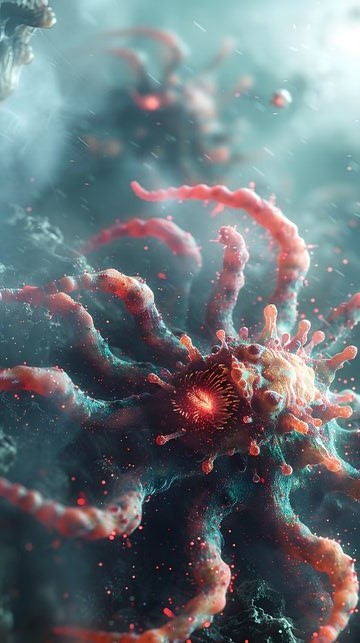
A space slag! Sinister and tenuous denizen of the interplanetary gulfs, it was so plastic, it could worm its way between the metal plates of a space ship. The strangest form of life in the Solar System, it traveled voraciously through the dark night of space. When hunger prodded it, it flattened itself to an amoeboid thinness and crept through microscopic crevices.
It was shaped like an echinoderm, a squirmy mass of radiant tentacles that could subdivide and coalesce with the speed of light. More resilient than protoplasm, it was capable of growth and reproduction and a purposive hunger that was hideous, malign.
A radio-active entity, it fed chiefly on volcanic detritus in the upper stratospheres of the active planets. Not only metal attracted it, but human beings and the carbon-rich bodies of Martians... It never descended on the planets...
- Red Moon
Stid: Not totally a creature of the void, then, if it relies on planets to provide its food.
Harlei: Have a heart, Stid - surely it can count as a space creature if it can cross space without artificial aid or protection. Do you expect it to eat space?
Stid: Well, who knows, space might be quite tasty to someone who can lunch on virtual particles... And esoteric physics apart, a creature which fed on radiation, which is basically what vegetation does, would have a better claim to the title of independent space-dweller, than one who has to browse on the tops of planetary atmospheres. One might next envisage space-critters that feed on the space vegetation... The sort of scenario, in fact, which you find in The Reefs of Space.
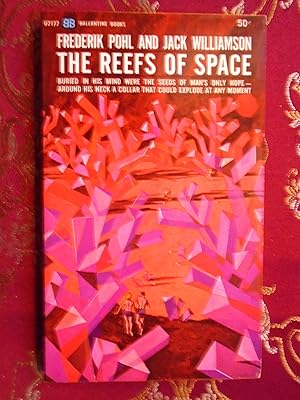
"...I've been thinking - about Hoyle's steady-state theory, and about another speculation he made. That life was born before the planets were, created by the chemical action of ultraviolet light in the cooling clouds of gas and dust around the sun. But how could it survive? The clouds disappear as the planets for.."
"Life adapts," the colonel said heavily...
He took a fresh drink. "Leaving out the intangibles," he lectured, "life is a phenomenon of matter and energy. The Hoyle Effect provides the matter, in the clouds of new hydrogen that are always being born between the stars. And life makes its own energy."
"How?"
"By fusing the hydrogen into heavier elements," the colonel said solemnly.
He flicked a switch. A screen slid down out of the ceiling. An image appeared on it, the image of little darting bodies, flashing with light, crossing the field of vision. The picture might have been of pond life under a microscope, except for the difference in shapes... and for the fact that these creatures gave off a light of their own. "The fusorians," said the colonel sombrely. "Hardy little things. They fuse hydrogen atoms and generate energy, and they live in space..."
Little things provide the basis for bigger things...
Colonel Lescure goes on to describe the Reefs.
"...An unearthly place. We came down in a brittle forest of things like coral branches. Thickets of shining crystal thorns snagged at our space suits when we went out exploring. We blundered through metal jungles that tripped and stabbed at us with sharp blades. And then there were stranger things still!
"There were enormous lovely flowers that shone with uncanny colours - and gave off deadly gamma rays. There was a kind of golden vine that struck back with a high-voltage kick when you touched it...
"We counted almost a hundred species. They must have grown from a few spores, drifting in the interstellar hydrogen. The rate of growth must be terribly slow - a few inches perhaps, in a million years. But the fusorians have time..."
Most remarkable of all, however, are the furry, warm-blooded "spacelings" who can move through the void by means of an innate "jetless drive"; who exist in symbiosis with the fusorians that enable them to coat their air-breathing bodies with a film of atmosphere. (It's the pressure to find the secret of this drive which provides the dystopian tale with its political plot.)
what not to include
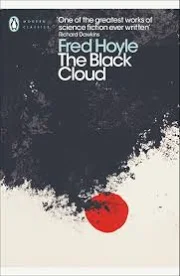
Zendexor: Stid, you give the novel high marks, and so do I. And you're on the right lines when you suggest the creatures of The Reefs of Space are more thoroughly adapted than anything that has to feed off planets' atmospheres. On the other hand not all tales of space-creatures have to be on that level; we ought to affirm that the pass mark is lower - the one crucial criterion for membership of the space-dwellers' club is the ability, as Harlei says, to "cross space without artificial aid or protection", so don't worry, Harlei: in this respect your atmosphere-browsers obviously fit the bill too.
Not all space-dwellers are germane to the issue, however. Consider a possible red herring: The Black Cloud.
This is a great classic, one of those personal favourites of which I've lost count of the readings. But it shouldn't be squeezed in to fit here. The Cloud is simply too big. Bigger than a planet, in fact; almost a solar system in size. Yet it's a sentient creature, and crosses space, migrating from star to star. In that sense it's a "creature of the void". It's just not the sort of thing we intend to focus on here; so how do we exclude it? Answer, by stipulating that we choose here to discuss creatures which would fit on a planetary surface, but which live in space instead.
That way we avoid getting side-tracked into planetary intelligences (or eggs - as in Jack Williamson's Born of the Sun), stellar or nebular consciousness (Stapledon's Star Maker and Nebula Maker), or the above-mentioned Black Cloud - cute topics though they all are. No, here we want, for example:
predatory abductors
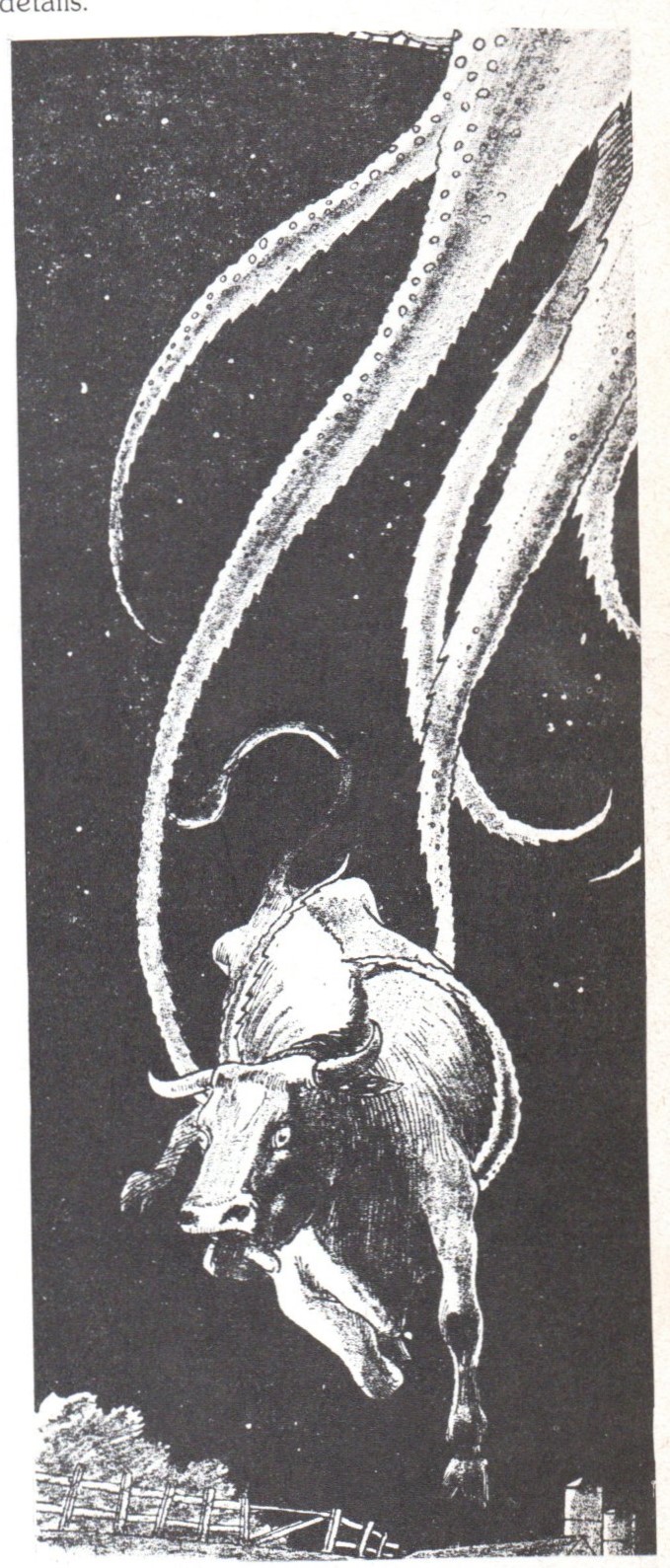 illustration by Leo Morey for "Dragons of Space"
illustration by Leo Morey for "Dragons of Space"...the more they were warned, the less they heeded. The like had never been heard of — was outside their experience or belief. Such fantastic creatures as the police were trying to frighten them with were simply absurd. There could not be intelligent living beings of any such sort. The prevalent verdict was that there was no such animal. They would assuredly have known it before if there had been. Did the police think they were children to run into the house and hide in a closet, just because something or other had blundered accidentally into their atmosphere?
So they laughed and went about the business of making a little more money. An aerocar would be flying along; an automobile on the highway; men at work in the fields; women and children on picnics; groups of people here and there — then a swift, soundless swoop from above, the suffocating embrace of the creatures of their unbelief, and that was the end for the men, women and children. The people were literally “gobbled up” by the thousands as the number of the enemy increased during the succeeding weeks.
The larger ships were not molested at first, the intelligent creatures evidently either realizing that the big craft were too much for them, or else awaiting the time when easier prey should be lacking.
Over the United States the sinister dragons of the ether, in ever-multiplying numbers, hovered and dived, wheeled and dived again and again, ghostly, foul, nauseous; and each time, human beings or animals passed into the ravening maws...
Thus the author of Dragons of Space introduces the peril, which eventually costs the Earth half its population. The story provides some satire as it mocks the initial mockery of the press, quoting from a disbelieving newspaper:
“...As freely predicted by The Clarion at the time, the election of ‘General’ Ulysses Abraham Cohen as Chief of Police two years ago is turning out a ludicrous blunder. Yesterday this remarkable man, without the slightest justification so far as we are aware, issued his imperial ukase, all wafered and sealed and done up in impressive baby ribbon, to the effect that henceforth all aircraft are to keep away from the air, under dire penalties. Somebody told him, it seems, that he had seen an animal up in the air over the city. Yes, dear reader, you heard correctly — an animal up in the air...
“For the first time in our memory, words entirely fail us. We seem to recall reading in our nursery days about a frolicsome beast that jumped over the moon, and it is of course just possible this is what is causing our worthy Chief of Police to tremble and his teeth to chatter so audibly. If so, we suggest that the milk maid call her bossy down, slap her ears, and guard her more carefully in future. There is no predicting what dire disaster this humorous bovine might inflict — on the minds of General Cohen and his intrepid men. We entreat our readers to be kind to the police and refrain from startling them by any sudden or unaccustomed sounds or movements.”
...The people laughed over their breakfast coffee, toast and eggs, and proceeded to fly to their business as usual...
- until they, and the press, couldn't laugh any more.
Stid: So what exactly are these "Dragons of Space"?
Zendexor: The author defines them as "...creatures that are neither human nor animal; neither flesh, blood, and bones, as we understand the terms, nor spirit, as we understand that term, but partake of both — and perhaps something else. Weird, unbelievable essences, entirely outside the pale of all usual experience and conception, and yet that are conscious, thinking, and to some extent, at least, reasoning beings..."
As time goes on they are referred to as elementals.
trying to pin down the elementals
"Now, Professor, I wish you would tell us what you know about these so-called elementals.”
Sanderson hesitated, shook his head dubiously. “That is rather a task, Mansonby. It is true I have made some little study of the subject, but only casually and with more particular reference to its bio-physical aspect — that is, as an item of current bio-physics. To give anything like an intelligent answer to your question it would be necessary to go rather deeply into the general composition of matter; the fundamental principles underlying what are usually referred to as physical or material things, and what are sometimes but inaccurately termed metaphysical or immaterial; to elucidate the nature of, and the character of the association between the so-called material and the so-called spiritual..."
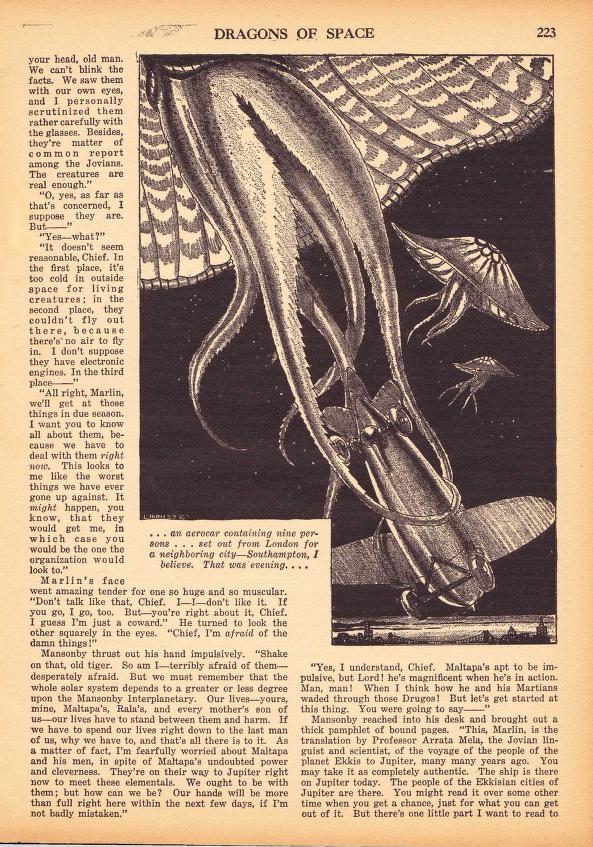
Stid: That sure casts the plot-net widely.
Zendexor: The tale actually does make quite a few demands on the concentration of the reader. Like other writers of around 1930, the author doesn't shy from loading the reader with wodges of clunky exposition. It's a stylistic fault, but at least it differs from the excessively action-packed
bang-bang-you're-dead
kind of tale.
“We are learning that the real activities of Nature are in what has been dismissed as ‘empty space,’ and it is there scientists have gone to seek them. It is there the important acts go on, the vital things occur. Far from being ‘empty,’ space is more vibrant and vital than the so-called ‘material things.’ The more tenuous things have assumed the major, the denser ones the minor, roles..."
Stid: Yet Morey's illustrations seem to show the space-creatures as dense enough. Look at that picture of an aeroplane being picked up...
Zendexor: I know - and it's possibly an inconsistency in the story. But then again, perhaps not. The author makes the point that we humans are mostly empty space, because of the predominant spaciousness of most matter. Anyhow, the space-creatures are strong though light. They are hard to kill - it takes lightning to burn them to ash (clunky prose wodge alert):
...a message came through from Tardieux, Mansonby’s French operative, who was pursuing the investigation at the scene of the disappearance of the two horseback riders in France. Following up certain rumors from the region, he had gone into the mountains a hundred miles from the actual scene. Here he had found a mysterious thing that for want of a better name he called a skeleton. It was roughly the shape of a rather deep and rounded umbrella-top, and 73 feet in diameter. The thing was not a skeleton in the sense in which the word is usually applied to the bony structure of an animal. The creature had had no bones, and the remains had the appearance of a burned out honeycomb of tissue paper, consisting for the most part of a delicate feathery ash, white or grayish white in color, barely substantial enough to retain its shape. He had taken several pictures of it, where it lay in a sheltered place among the cliffs, which was fortunate, for shortly afterward a gust of wind had blown the greater part of it away.
The parts remaining consisted of delicate but extremely tough, fibrous membranes, appearing semimetallic with a strong coppery content. These fibers had circled the body many times and connected with four complex masses, one on each side of the center. These were roughly circular with a diameter of something less than a foot and in turn connected with a central mass a trifle over three feet in diameter.
Tardieux’s supposition was that the creature had been struck by lightning during an exceptionally violent electrical storm which had recently occurred in the locality where it was found.
Stid: Oh dear: that's 1930 pulp prose for you: "which had recently occurred in the locality where it was found"...
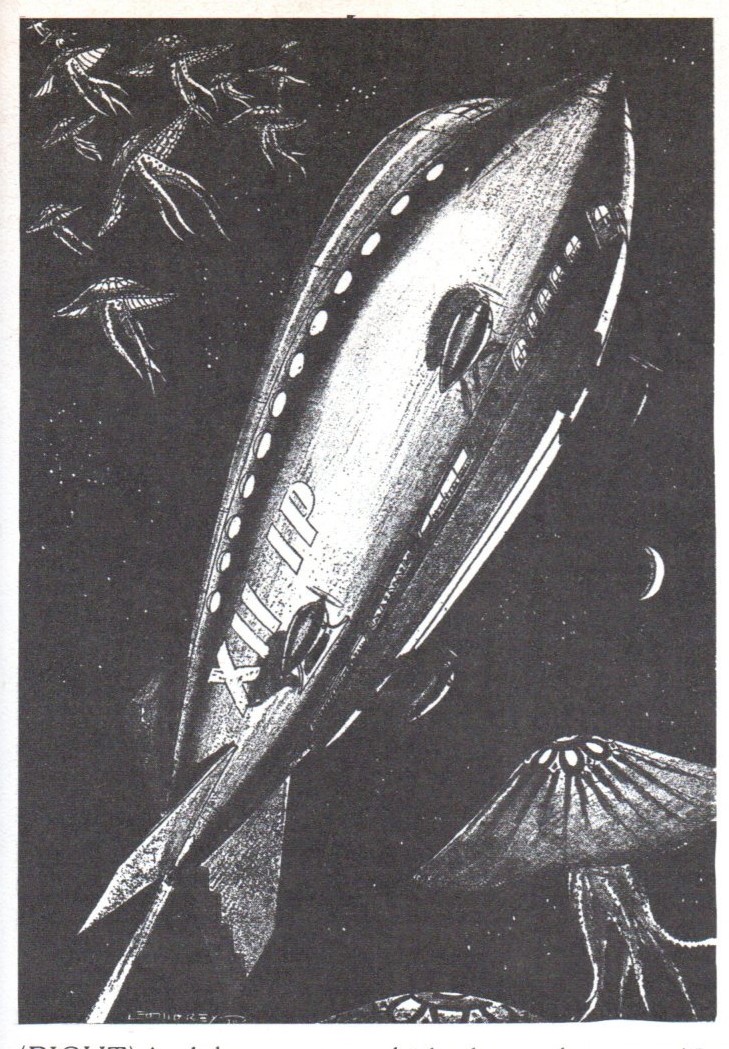 illustration by Leo Morey
illustration by Leo MoreyZendexor: Quite. I find it quite inspiring, though, to think about all those readers of 1930 poring over such rather heavy speculative stuff. And they do get rewarded with some space-faring drama.
The Interplanetary fleets carried such as cared to go to other planets, only to find that they would have been as well or better off at home. By this time every inhabited planet in the Solar System (and every uninhabited one, too, so far as anyone could say) was blanketed with the unhallowed scourge. Interplanetary travelers reported the elementals swarming everywhere throughout space. It seemed as if the whole cavernous hells of the limitless void were vomiting their grisly contents entire upon the race of humans to harry them out of being.
uranium-eaters
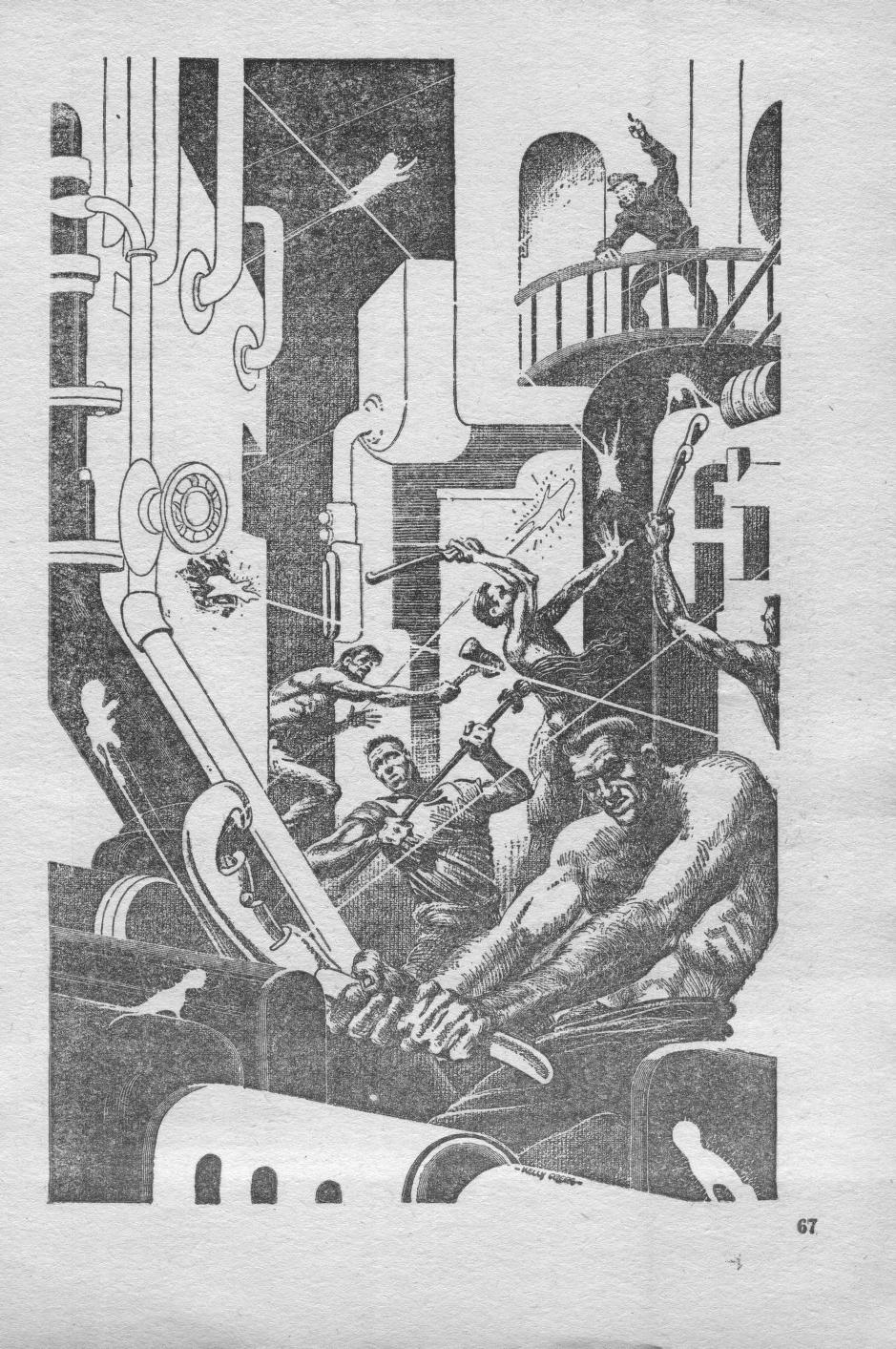
Having spent so much page-space on this clunker of a tale from 1930, let's now bid farewell to Dragons of Space and glance at a much shorter piece which may show us some progress in the style of the pulps between 1930 and 1954.
Creatures found on an asteroid in Feline Red turn out to have a taste for uranium and to breathe vacuum. It's not clear whether they cross space or not, but I should think they do, since one asteroid isn't likely to be enough for them.
"Look out,” Scott snapped.
With a crisp smack, a red creature the size of a man’s hand struck the rail before them. It was all improbable angles, with no special shape, no front or back. It teetered crazily over the ten foot drop to the floor below. Then it settled, sputtering. It sounded curiously like an angry cat.
beyond matter-as-we-know-it
To round off our survey with a section on invisible beings...
Stid: Wait, that sounds a bit boring. Don't you prefer to read stories about beings who can be seen?
Zendexor: It depends. I'd say that the living radiation which is discovered at the end of Macroscope leaves a visible impression on the reader!
And what about the wonderfully "hypersomatic" eldila in Out of the Silent Planet and its sequels?
Here's the protagonist, Ransom, returning home from Mars by spacecraft in a journey which offers scant hope of physical survival - but which has its compensations, now that he has learned of the inhabitants of space:
...he heard, or thought he heard, all kinds of delicate sound, or vibrations akin to sound, mixed with the tinkling rain of meteorites, and often the sense of unseen presences even within the space-ship became irresistible. He and all his race showed small and ephemeral against a background of such immeasurable fullness. His brain reeled at the thought of the true population of the universe, the three-dimensional infinitude of their territory, and the unchronicled aeons of their past...
I wouldn't call the eldila "pure energy" since they may have material
and structure of a kind, only invisible to us because of their high
vibration-rate. The learned Martian sorn had previously explained to Ransom:
...The swiftest thing that touches our senses is light. We do not truly see light, we only see slower things by it, so that for us light is on the edge - the last thing we know before things become too swift for us. But the body of an eldil is a movement swift as light; you may say its body is made of light, but not of that which is light for the eldil. His 'light' is a swifter movement which for us is nothing at all; and what we call light is for him a thing like water, a visible thing, a thing he can touch and bathe in...
Comparing this with Dragons of Space, it appears notable how two authors so far apart in ability can be at one in realizing that an effort must be made to transcend categories, when one tries to depict life lived nakedly in the so-called "void".
addendum: do-it-yourself perils
Since finishing this page I have come across another relevant tale, one with a different slant on the topic.
The space-creatures in The Beasts in the Void arise (spoiler alert) out of the action of an intelligent "space fog" which has the urge to evolve and reproduce with the aid of material from the minds of space-farers. Thus, the crew of a ship find themselves with an Indian tiger and a Plutonian ice-bear suddenly on board.
They're mere copies of planetary animals, but still, they are created by energies which inhabit space, and so they count as Creatures of the Void.
Piers Anthony, Macroscope (1969); Paul W Fairman, "The Beasts in the Void" (Imagination, April 1956); Raymond Z Gallun, "A Beast of the Void" (Astounding, September 1936); Fred Hoyle, The Black Cloud (1957); C S Lewis, Out of the Silent Planet (1938); Frank Belknap Long, "Red Moon" (Thrilling Wonder Stories, June 1940); Frederick Pohl and Jack Williamson, The Reefs of Space (1964); Robert Sampson, "Feline Red" (Planet Stories, January 1954); Aladra Septama, "Dragons of Space" (Amazing Stories Quarterly, Spring 1930).
To set the record straighter see Missing out the most important creature-of-the-void.










































